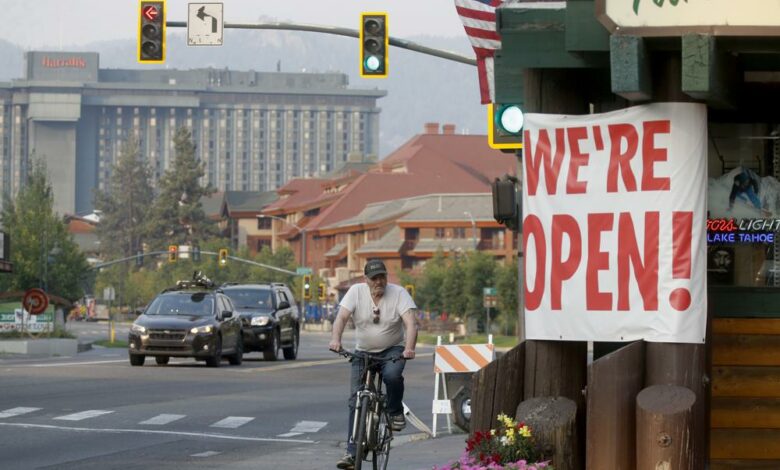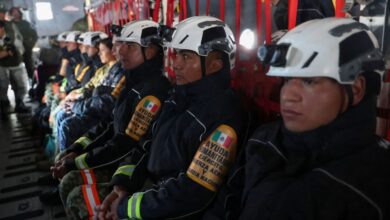
SOUTH LAKE TAHOE, Calif. (AP) — While firefighters confront aggressive winds and flames in some southeast sections of the Caldor Fire, many crews are shifting their focus to repairing areas for residents to return in the coming days — a sign of confidence that they’ll continue to make progress containing the wildfire.
Officials lifted the mandatory evacuation order for the 22,000 residents of South Lake Tahoe on Sunday, allowing some residents to trickle back into the smoke-cloaked city. But the wildfire remains 48% and areas south of the resort town like Meyers and the ski resort Kirkwood remain battlefields for the more than 5,000 personnel working to contain the 338 square-mile (876 square-kilometer) wildfire from threatening Lake Tahoe, the surrounding resort communities and the homes of employees who staff casinos, restaurants and ski resorts.
“We’re also looking long term — what’s going to happen, four, five or six days down the road. We want to make sure we’re planning and having stuff ready and completed so that when (repopulation) comes available,” Cal Fire official John Davis said. “And if it comes sooner, we are already in the planning process for the whole area that’s still under evacuation order.”
When the Caldor Fire gobbled up pine trees and crossed the Sierra Nevada last week, South Lake Tahoe, transformed into a ghost town. The city appeared slightly rebounded on Monday, yet mostly empty compared to normal holiday weekends.
“I was honestly convinced this place was gonna go down,” Lake Tahoe Community College student Dakota Jones said Monday upon his return. “It was nice to see that I was wrong.”
The lifting of mandatory evacuation orders for the Tahoe area marked a milestone in the fight against the Caldor Fire, which erupted Aug. 14 and spread across dense forests, tree-dotted granite cliffs and scattered cabins and hamlets in the northern Sierra Nevada. At its peak, the fire was burning as many as 1,000 acres an hour. Through tactics including bulldozing defense lines and air-dropping 1,600 gallons (6,057 liters) of Lake Tahoe water onto the flames, crews have successfully carved a perimeter around much of the wildfire.
Fire officials said they expected crews in hot spots to continue to confront challenging conditions, but hoped to make enough progress to lift evacuation orders still in place in the coming days. But much will depend on the weather, particularly the nature of wind and rain that thunderstorms expected next weekend may yield.
Winds have been easing, allowing firefighters to make progress containing the conflagration, but authorities remain concerned about southwest winds sparking spot fires. In Northern California, the weather is expected to cool slightly and the humidity to rise starting on Tuesday.
“We are drier than I have seen on my 20 days on this fire,” Jim Dudley, incident meteorologist, said Monday. “There’s a lot of potential weather-wise for little things to become maybe not so little.”
California and much of the U.S. West have experienced dozens of wildfires in the past two months as the warming, drought-stricken region swelters under dry heat and winds drives flames through vegetation. More than 14,500 firefighters were battling 14 active fires in the state on Monday, and since the year began more than 7,000 wildfires have devoured 3,000 square miles (8,000 square kilometers).
No deaths have been reported specifically from the fires, which have shut down all national forests in the state.
Further south, the National Weather Service in Oxnard, California said hot dry weather was expected for interior valleys and deserts with elevated fire conditions through Friday.
___
Metz is a corps member for the Associated Press/Report for America Statehouse News Initiative. Report for America is a nonprofit national service program that places journalists in local newsrooms to report on undercovered issues.




